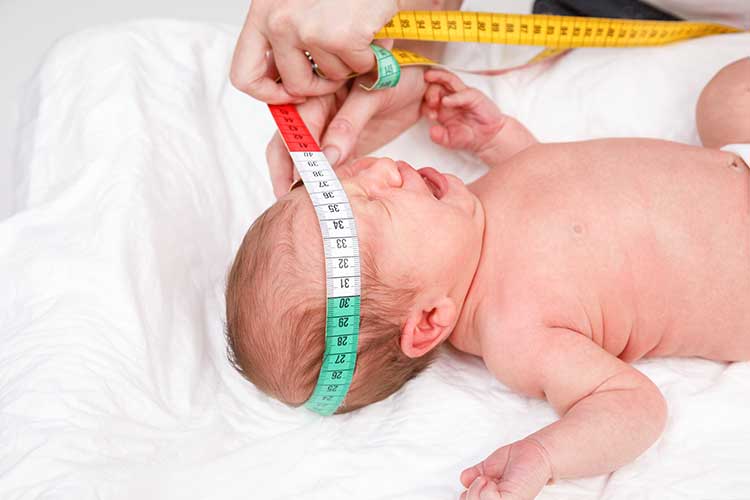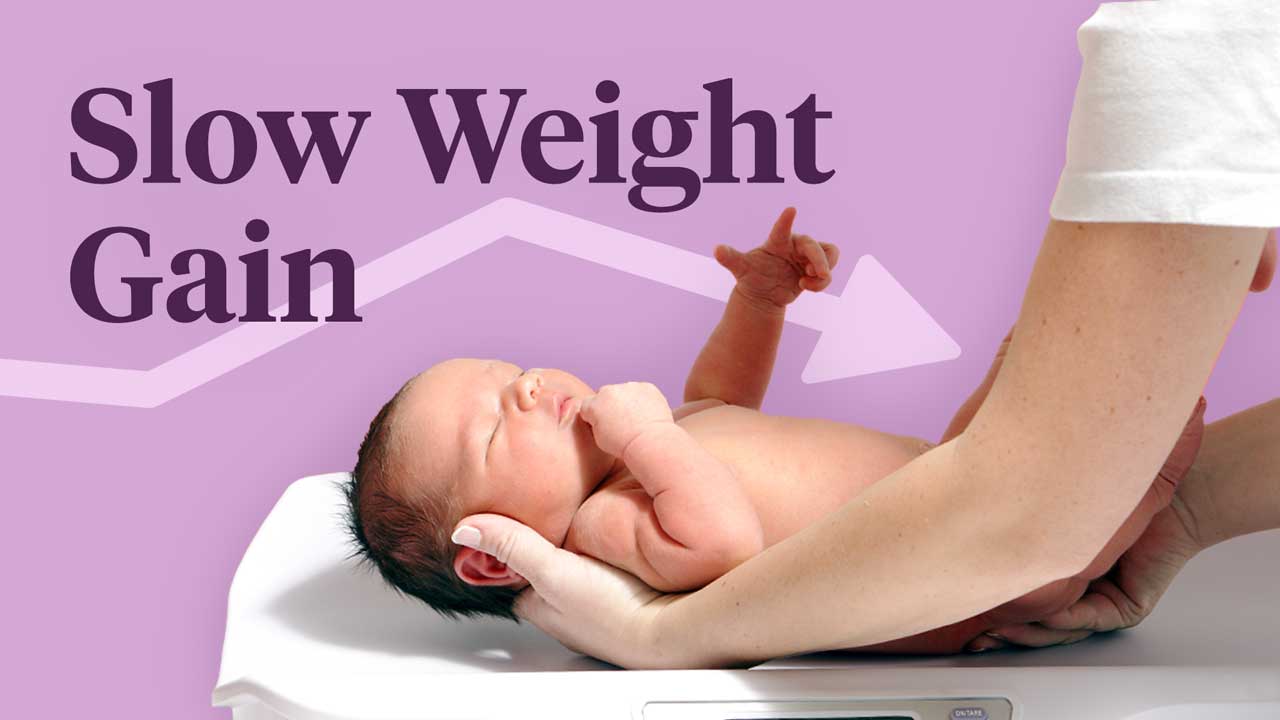What is Slow Weight Gain?
Slow weight gain, also known as faltering growth or failure to thrive, describes a pattern of poor weight gain in children (Pregnancy, Birth & Baby 2023; Starship 2022).
Generally, this term applies to children whose weight, or rate of weight gain, is considerably lower than what is expected for other children of the same age and sex or if their weight has fallen by two or more percentile lines (RCHM 2021).
Faltering growth may be indicative of insufficient growth for the child’s health and development (RCHM 2021).
Often, the child’s length and head circumference will be unaffected unless they experience a prolonged or severe period of poor nutrition (RCHM 2021).
Slow weight gain is an umbrella term that describes a growth pattern - it is not a condition that is diagnosed (Starship 2022).
Note: It is normal for newborns to lose up to 10% of their birth weight in the first few days of life. This weight is generally regained within two to three weeks once feeding has been established (Healthdirect 2024).

Causes of Slow Weight Gain
Generally, slow weight gain occurs when a child is consuming or using less nutrition than they require (Smith et al. 2023). This may be due to:
- Medical causes, which impair the body’s ability to use food to grow and develop
- Environmental causes, which prevent the child from being fed adequately
- Behavioural causes, wherein the child is offered adequate food but does not consume enough.
(Pregnancy, Birth & Baby 2023)
| Medical causes |
|
| Environmental causes |
|
| Behavioural causes |
|
(RCHM 2021; Smith et al. 2023; Willacy 2022; Pregnancy, Birth & Baby 2023; Cleveland Clinic 2024)
Interestingly, most cases of faltering growth (up to 80%) appear to be inorganic (caused by environmental factors rather than medical conditions) (Graber 2025).
Supporting the Parents of Children With Slow Weight Gain
It is important to note that neglect is not usually the cause of slow weight gain. Parents of children with slow weight gain are often made to feel responsible for their child’s faltering growth, so providing appropriate emotional support to the child’s parents is an integral part of the healthcare professional’s role (Gonzalez-Viana et al. 2017).
As feeding and growth can be highly sensitive parenting topics, it is crucial to avoid instilling unnecessary anxiety and guilt in parents.
Instead, parents should be actively engaged with and involved in the investigation process (Graber 2025). Ensure that you:
- Encourage parents to visit often and for long periods of time (if the child has been admitted to hospital)
- Make parents feel welcome
- Support the parents’ attempts to feed their child
- Encourage parent-child play by providing toys.
(Graber 2025)
Signs of Slow Weight Gain

Signs of slow weight gain may include:
- Fatigue
- Irritability
- Constipation
- Failing to meet developmental milestones.
(Graber 2025)
Complications of Slow Weight Gain
Poor growth during childhood may lead to health and development issues such as:
- Altered growth potential
- Neurodevelopmental complications (e.g. reduced IQ, learning disability, poor communication skills)
- Behavioural issues
(Smith et al. 2023; Rabinowitz 2024)
How is Slow Weight Gain Assessed?
Assessing the Child’s History
The healthcare professional should take into account:
- The child’s intake:
- Whether the child is breastfed or bottle-fed
- The amount and duration of feeds within a 24-hour period
- Breast milk supply/formula preparation
- The age at which solid foods were introduced
- The composition of solid foods consumed
- The number and quantity of snacks and meals consumed
- (For toddlers) Milk intake within a 24-hour period
- Gestational age at birth and birth weight
- The child’s output:
- Losses such as vomiting, stools, urine and others (e.g. stoma)
- Triggers that may lead to increased output (e.g. certain foods)
- The child’s food behaviour and dietary practices:
- Whether the child is accepting of food or needs to be coerced/distracted
- Set-up and duration of mealtime
- Whether the child has any dietary restrictions
- The child’s past history:
- Whether the child has a chronic or current illness, or recurrent infection
- The child's immunisation status
- Family growth:
- The pattern of weight gain and growth in the child’s relatives
- Mid-parental height
- Psychosocial assessment of the family in order to identify any signs of family vulnerability
- Whether the child is at increased risk of slow weight gain (see above)
- Recent or concurrent illness (e.g. infections, severe asthma, eczema)
- The child’s social history, including:
- Parental mental illness
- Lack of financial resources for food requirements
- Unsuitable housing
- Lack of family or community support
- Whether the child is a refugee or recent immigrant
- Failure to attend hospital or community services appointments
- History of child protection involvement
- Medicines being taken by the child.
(RCHM 2021; SA Health 2024; Queensland Health 2024)
Examination of the Child
The healthcare professional should assess the following:
- The child’s overall appearance; do they look well and in proportion?
- Hydration status
- Signs of underlying systemic illness
- Growth pattern (by plotting serial measures of weight, height and head circumference)
- Any changes in growth trajectory and the circumstances surrounding these changes (e.g. introduction of solid foods)
- Mid-parental height
- Muscle bulk (i.e. buttocks), subcutaneous fat stores (i.e. thighs), skin, hair, gums, eyes and nails
- Developmental level
- Interactions between the child and their caregiver
- Any signs of abuse or neglect
- The child’s feed, if possible.
(RCHM 2021)

Additional Investigations
Generally, if the child appears well, is developing normally and has normal findings from clinical examination and initial investigations, there is no cause for concern (RCHM 2021).
However, in some cases, the child may need to undergo additional screening investigations if their history or examination suggests a particular diagnosis. Possible investigations that may be considered include:
- Urine tests: urinalysis, microscopy and culture
- Blood tests:
- FBE, ferritin, UEC, TSH, glucose and LFT
- Coeliac serology and total IgA (if the child is consuming solids or feed containing gluten)
- Micronutrients, particularly active B12 (if malabsorption or restricted dietary intake is suspected)
- Stool tests: microscopy, fat globules and fatty acid crystals
- ESR and faecal calprotectin testing (in children over 12 months of age)
- Specific screening for metabolic, immune or genetic issues (if required).
(RCHM 2021)
Management of Slow Weight Gain
Management of slow weight gain should involve an interprofessional team, which may comprise:
- Child health nurses or lactation consultants
- General practitioners
- Paediatricians
- Dieticians
- Speech pathologists
- Interprofessional feeding clinic
- Psychologists
- Infant mental health clinicians
- Social worker or child protection services.
(RCHM 2021)
Treatment will depend on specific underlying factors. Most children can be managed as outpatients, however, those displaying red flags may require consultation with a paediatric team (RCHM 2021).
Red flags include:
- Severe malnutrition, illness or dehydration
- Failure to manage the child as an outpatient
- Suspected parental abuse or neglect
- Severe parental mental health concerns.
(RCHM 2021)
Test Your Knowledge
Question 1 of 3
Which one of the following best describes slow weight gain in children?
Topics
References
- Cleveland Clinic 2024, Growth Faltering (Formerly Known as Failure To Thrive), Cleveland Clinic, viewed 28 May 2025, https://my.clevelandclinic.org/health/diseases/failure-to-thrive
- Gonzalez-Viana, E, Dworzynski, K, Murphy, MS & Peek, R 2017, ‘Faltering Growth in Children: Summary of NICE Guidance’, BMJ, viewed 28 May 2025, https://www.bmj.com/content/358/bmj.j4219
- Graber, EG 2025, Growth and Weight Faltering in Children, MSD Manual, viewed 28 May 2025, https://www.msdmanuals.com/professional/pediatrics/growth-and-development/growth-and-weight-faltering-in-children
- Healthdirect 2024, How Your Baby Gains Weight, Australian Government, viewed 28 May 2025, https://www.healthdirect.gov.au/how-your-baby-gains-weight
- Perth Children’s Hospital 2022, Failure to Thrive, Government of Western Australia, viewed 22 May 2025, https://pch.health.wa.gov.au/For-health-professionals/Referrals-to-PCH/Prereferral-guidelines/Failure-to-thrive
- Pregnancy, Birth & Baby 2023, Slow Weight Gain, Healthdirect Australia, viewed 22 May 2025, https://www.pregnancybirthbaby.org.au/slow-weight-gain
- Queensland Health 2024, Faltering Growth (Failure to Thrive) in Children < 6 Years, Queensland Government, viewed 28 May 2025, https://cpc.health.qld.gov.au/Condition/262/faltering-growth-failure-to-thrive-in-childre
- Rabinowitz, SS 2024, Nutritional Considerations in Failure to Thrive, Medscape, viewed 28 May 2025, https://emedicine.medscape.com/article/985007-overview#a1
- Royal Children's Hospital Melbourne 2021, Slow Weight Gain, RCHM, viewed 22 May 2025, https://www.rch.org.au/clinicalguide/guideline_index/Slow_weight_gain/
- SA Health 2024, Faltering Growth/Failure to Thrive - Paediatric CPC, Government of South Australia, viewed 28 May 2025, https://www.sahealth.sa.gov.au/wps/wcm/connect/public+content/sa+health+internet/services/outpatients/cpc/specialities/paediatric+medicine/faltering+growth+or+failure+to+thrive+paediatric+cpc
- Smith, AE, Shah, M & Badireddy, M 2023, ‘Failure to Thrive’, StatPearls, viewed 28 May 2025, https://www.ncbi.nlm.nih.gov/books/NBK459287/
- Spencer, NJ 2007, ‘Failure to Think About Failure to Thrive’, Archives of Disease in Childhood, vol. 92, no. 2, viewed 28 May 2025, https://www.ncbi.nlm.nih.gov/pmc/articles/PMC2083320/
- Starship 2022, Faltering Growth - Failure to Thrive, Starship, viewed 22 May 2025, https://www.starship.org.nz/guidelines/faltering-growth-failure-to-thrive/
- Willacy, H 2022, Faltering Growth in Children, Patient, viewed 28 May 2025, https://patient.info/doctor/faltering-growth-in-children

